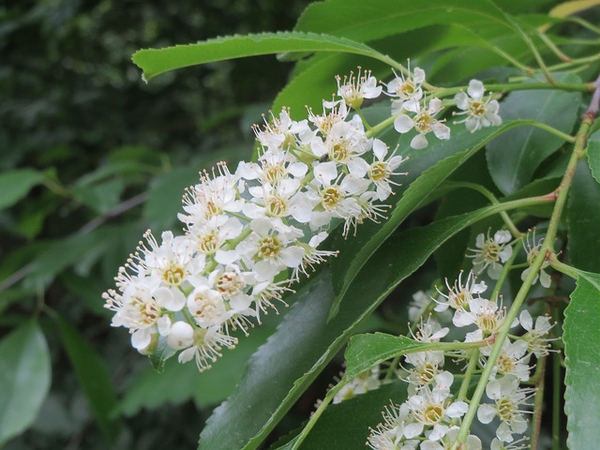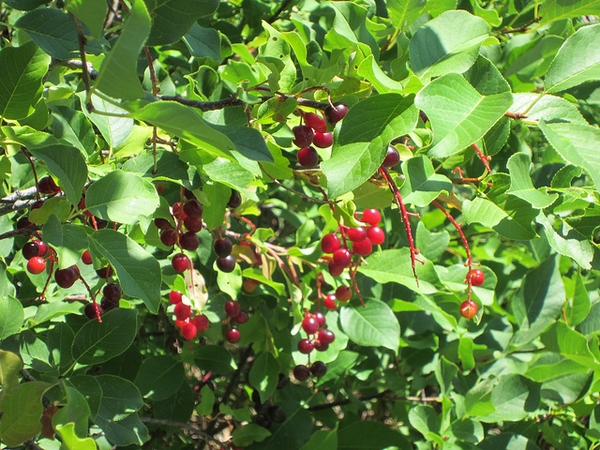Name That Tree
By Gil Medeiros
If you said this one is a Black Cherry(Prunus serotina), you are correct. Your prize this month is a little bag of Black Cherry seeds. These seeds are spherical and resemble little ball bearings. Like ball bearings, they can be very slippery under foot. You must promise not to spread your bag of seeds on a darkened sidewalk.

These flowers of Black Cherry appear in May
The wood is valuable, and the fruit it is ecologically significant, but there is one more thing. The inner bark is the key ingredient in wild cherry cough syrup. If you Google it, you will find numerous commercial products and do-it-yourself recipes.
The Black Cherry is a native to North America according to authoritative university references. Here’s one for the “turnabout is fair play” department. Black Cherry was exported to Europe because of the quality of its wood. But, as so often happens when plants are moved from one continent to another, the Black Cherry has become an invasive weed tree in Germany, Belgium and the Netherlands.
 Did I mention that this is a messy tree? I think so, but I should say more. The biggest mess comes from the fruit. (A botanical terminology alert: these are technically called “drupes”.) The fruit of this prolific tree provides an annual feast for all kinds of birds. The ungrateful birds repaid my favor of caring for the Black Cherry by spreading the digested remains of the feast everywhere. Over the 39 Augusts that I lived with a Black Cherry, I became accustomed to purple stains on the deck, on walkways and on the driveway. The pavement stains were largely washed away by August downpours and faded under the still intense summer sun. The stains on the deck, however, usually needed a chemical detergent and the action of a stiff brush. And over the years, I pulled up hundreds of Black Cherry seedlings from garden beds.
Did I mention that this is a messy tree? I think so, but I should say more. The biggest mess comes from the fruit. (A botanical terminology alert: these are technically called “drupes”.) The fruit of this prolific tree provides an annual feast for all kinds of birds. The ungrateful birds repaid my favor of caring for the Black Cherry by spreading the digested remains of the feast everywhere. Over the 39 Augusts that I lived with a Black Cherry, I became accustomed to purple stains on the deck, on walkways and on the driveway. The pavement stains were largely washed away by August downpours and faded under the still intense summer sun. The stains on the deck, however, usually needed a chemical detergent and the action of a stiff brush. And over the years, I pulled up hundreds of Black Cherry seedlings from garden beds.
Black Cherry is tolerant of all kinds of soil: acidic, alkaline, clay and sandy. If you spot a mature specimen in your neighborhood, it is probably 50 to 60 feet in height. They can be much taller. The Virginia state champion, located in Tazewell, measures 92 feet in height from the ground to its highest twig.
Black Cherry is normally free of disease and insect problems. Like other types of cherry, however, it will suffer an occasional visit from black knot, a fungal disease. To rid the tree of black knot, the tree’s caretaker will need to remove the affected limb(s).
Early spring occasionally brings the onset of dreaded tent caterpillars. Talk about a mess — these guys leave behind a layer of fecal pellets under the tree! During population “boom” periods, tent caterpillars may defoliate a Black Cherry. A healthy tree will refoliate; a tree weakened by drought or some other condition may not survive.
References
Prunus serotina: Black Cherry, #ENH-675, University of Florida Extension
Black Cherry, University of Kentucky, Department of Horticulture
NH Big Tree of the Month — April 2007 Black Cherry — Prunus serotina, University of New Hampshire Cooperative Extension
Camping with the Tent Caterpillars, Fairfax Gardening